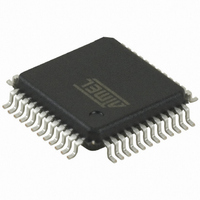AT32UC3B1256-AUR Atmel, AT32UC3B1256-AUR Datasheet - Page 377

AT32UC3B1256-AUR
Manufacturer Part Number
AT32UC3B1256-AUR
Description
MCU AVR32 256K FLASH 48-TQFP
Manufacturer
Atmel
Series
AVR®32 UC3r
Datasheet
1.AT32UC3B164-AUR.pdf
(680 pages)
Specifications of AT32UC3B1256-AUR
Package / Case
48-TQFP, 48-VQFP
Voltage - Supply (vcc/vdd)
1.65 V ~ 1.95 V
Operating Temperature
-40°C ~ 85°C
Speed
60MHz
Number Of I /o
28
Core Processor
AVR
Program Memory Type
FLASH
Ram Size
32K x 8
Program Memory Size
256KB (256K x 8)
Data Converters
A/D 6x10b
Oscillator Type
Internal
Peripherals
Brown-out Detect/Reset, DMA, POR, PWM, WDT
Connectivity
I²C, IrDA, SPI, SSC, UART/USART, USB
Core Size
32-Bit
Lead Free Status / RoHS Status
Lead free / RoHS Compliant
Eeprom Size
-
Available stocks
Company
Part Number
Manufacturer
Quantity
Price
Company:
Part Number:
AT32UC3B1256-AUR
Manufacturer:
OMRON
Quantity:
12 000
- Current page: 377 of 680
- Download datasheet (10Mb)
32059J–12/2010
U(P/E)RST.(E)PENn = 1
U(P/E)CFGn.ALLOC = 1
Pipes/Endpoints 0..5
Free Memory
Activated
configuration (the Pipe Banks (PBK) field, the Pipe Size (PSIZE) field, the Pipe Token (PTO-
KEN) field, the Pipe Type (PTYPE) field, the Pipe Endpoint Number (PEPNUM) field, and the
Pipe Interrupt Request Frequency (INTFRQ) field in the Pipe n Configuration (UPCFGn) regis-
ter/the Endpoint Banks (EPBK) field, the Endpoint Size (EPSIZE) field, the Endpoint Direction
(EPDIR) field, and the Endpoint Type (EPTYPE) field in UECFGn).
To free its memory, the user shall write a zero to the UECFGn.ALLOC bit. The n+1 pipe/end-
point memory window then slides down and its data is lost. Note that the following pipe/endpoint
memory windows (from n+2) does not slide.
Figure 22-8 on page 377
example.
Figure 22-8. Allocation and Reorganization of the DPRAM
1. The pipes/endpoints 0 to 5 are enabled, configured and allocated in ascending order.
2. The pipe/endpoint 3 is disabled, but its memory is kept allocated by the controller.
3. In order to free its memory, its ALLOC bit is written to zero. The pipe/endpoint 4 memory
4. If the user chooses to reconfigure the pipe/endpoint 3 with a larger size, the controller
Note that:
• There is no way the data of the pipe/endpoint 0 can be lost (except if it is de-allocated) as
• Deactivating then reactivating a same pipe/endpoint with the same configuration only modifies
PEP5
PEP4
PEP3
PEP2
PEP1
PEP0
memory allocation and de-allocation may affect only higher pipes/endpoints.
temporarily the controller DPRAM pointer and size for this pipe/endpoint, but nothing changes
in the DPRAM, so higher endpoints seem to not have been moved and their data is preserved
Each pipe/endpoint then owns a memory area in the DPRAM.
window slides down, but the pipe/endpoint 5 does not move.
allocates a memory area after the pipe/endpoint 2 memory area and automatically slides
up the pipe/endpoint 4 memory window. The pipe/endpoint 5 does not move and a mem-
ory conflict appears as the memory windows of the pipes/endpoints 4 and 5 overlap. The
data of these pipes/endpoints is potentially lost.
U(P/E)RST.(E)PEN3 = 0
Pipe/Endpoint 3
(ALLOC stays at 1)
Free Memory
Disabled
PEP5
PEP4
PEP3
PEP2
PEP1
PEP0
illustrates the allocation and reorganization of the DPRAM in a typical
U(P/E)CFG3.ALLOC = 0
Pipe/Endpoint 3
PEP4 Lost Memory
Memory Freed
Free Memory
PEP5
PEP4
PEP2
PEP1
PEP0
U(P/E)RST.(E)PEN3 = 1
U(P/E)CFG3.ALLOC = 1
Pipe/Endpoint 3
PEP3 (larger size)
Free Memory
Activated
PEP4
PEP2
PEP1
PEP0
PEP5
AT32UC3B
Conflict
377
Related parts for AT32UC3B1256-AUR
Image
Part Number
Description
Manufacturer
Datasheet
Request
R

Part Number:
Description:
DEV KIT FOR AVR/AVR32
Manufacturer:
Atmel
Datasheet:

Part Number:
Description:
INTERVAL AND WIPE/WASH WIPER CONTROL IC WITH DELAY
Manufacturer:
ATMEL Corporation
Datasheet:

Part Number:
Description:
Low-Voltage Voice-Switched IC for Hands-Free Operation
Manufacturer:
ATMEL Corporation
Datasheet:

Part Number:
Description:
MONOLITHIC INTEGRATED FEATUREPHONE CIRCUIT
Manufacturer:
ATMEL Corporation
Datasheet:

Part Number:
Description:
AM-FM Receiver IC U4255BM-M
Manufacturer:
ATMEL Corporation
Datasheet:

Part Number:
Description:
Monolithic Integrated Feature Phone Circuit
Manufacturer:
ATMEL Corporation
Datasheet:

Part Number:
Description:
Multistandard Video-IF and Quasi Parallel Sound Processing
Manufacturer:
ATMEL Corporation
Datasheet:

Part Number:
Description:
High-performance EE PLD
Manufacturer:
ATMEL Corporation
Datasheet:

Part Number:
Description:
8-bit Flash Microcontroller
Manufacturer:
ATMEL Corporation
Datasheet:

Part Number:
Description:
2-Wire Serial EEPROM
Manufacturer:
ATMEL Corporation
Datasheet:











